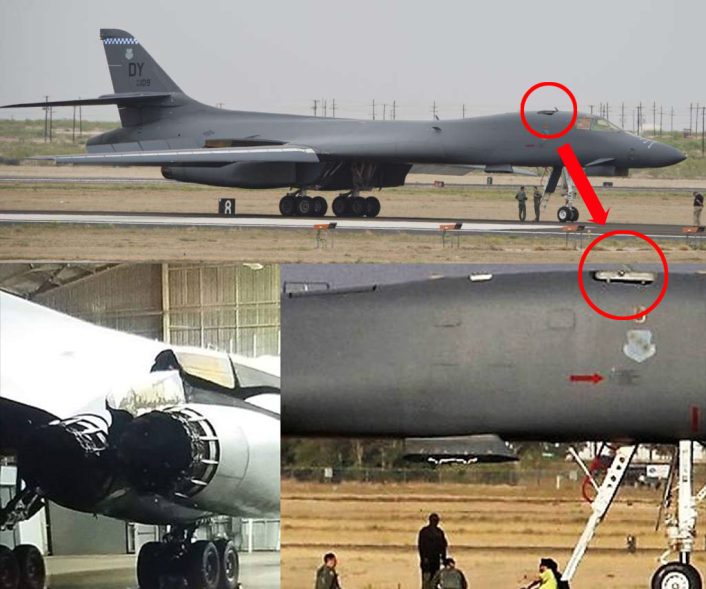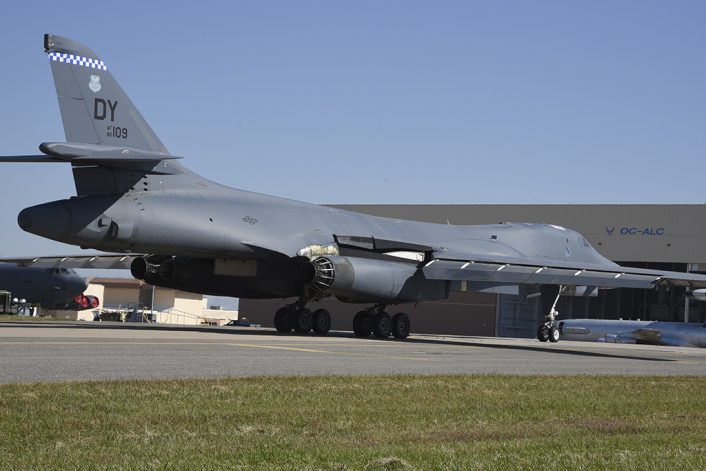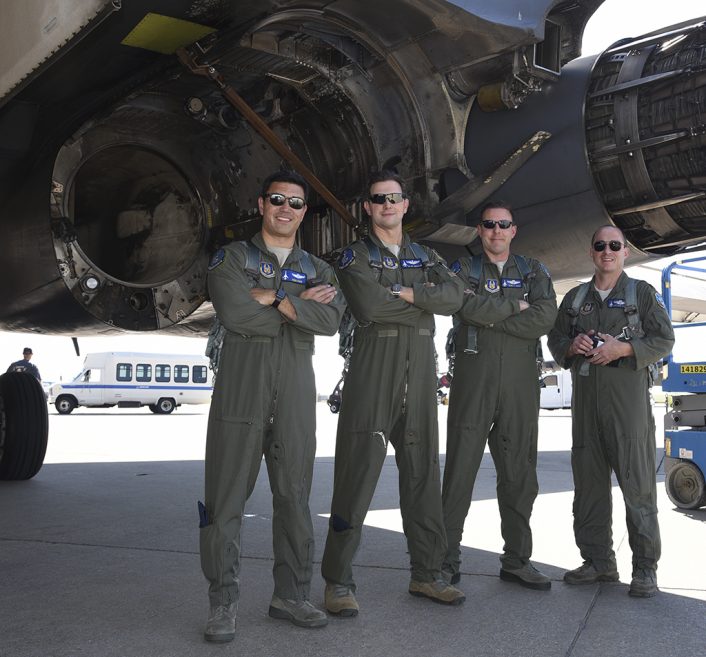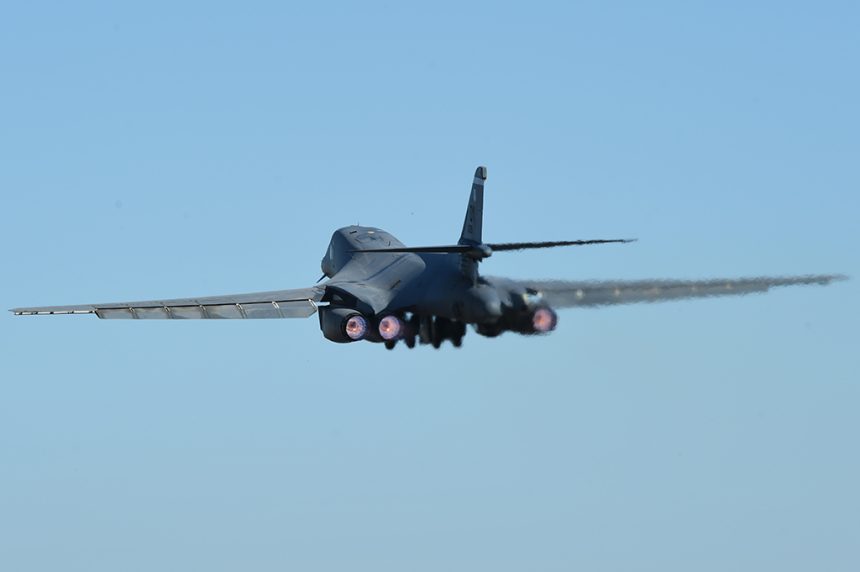The “Bone” at the Midland International Air & Space Port since May 1 was flown from Midland to Tinker Air Force Base, Oklahoma today. On Three Engines.
The B-1B Lancer that performed an emergency landing last May, was tranferred to Tinker AFB on Oct. 26, 2018.
The heavy bomber was on a training mission on May 1, 2018 when a serious engine fire erupted near the right wing root. There were fire warnings in three areas of the aircraft. All but one was extinguished by taking appropriate flight procedures, prompting the aircraft commander to heed technical orders and command a controlled manual ejection from their burning bomber over the Texas desert. When the first crew ejection seat failed to leave the plane successfully, the aircraft commander ordered the crew to immediately stop the escape procedure and managed to fly the damaged and burning aircraft with a crew hatch missing and the cockpit open to the surrounding wind blast to the Midland Air and Space Port near Odessa, Texas where the crew made a successful emergency landing.

For their heroism, the crew members were each presented the Distinguished Flying Cross in a ceremony July 13 at Dyess AFB.
“After undergoing a safety investigation board and maintenance to get the aircraft into a safely operable condition, an Air Force Reserve crew from the 10th Flight Test Squadron flew the aircraft to Tinker AFB. While at Tinker AFB, the B-1B will undergo depot maintenance and upgrades at the Oklahoma City Air Logistics Complex, be quality tested by the 10th FLTS, and be returned to the Dyess AFB B-1B Lancer fleet upon completion,” an official AFRC release said.
The 10th FLTS is a geographically separated unit of the 413th Flight Test Group that conducts functional check flights and acceptance check flights in B-1, B-52, E-3 and KC-135 aircraft.
Some more details about the unusual procedure to move the bomber to Tinker were provided by the always very well informed Air Force amn/nco/snco FB page that revealed that the aircraft was to be flown on 3 of 4 engines:
“OK flying on 3 of 4 engines, limited radar, and the landing gear must stay down for the entirety of flight due to possible hydro issues and the wings will not be able to sweep. One engine caught fire and spread to another engine, so they were removed. They replaced with one engine that cost between $2-3 million, hence flying back on 3 of 4 engines. The hatch that had blown off has been replaced and ejection seats work. They are currently doing Dash 1 checks.”
The following images show the 3-engine B-1 on the ground after its arrival in Tinker AFB.


It looks like it’s not the first time a B-1 takes-off on three engines after an emergency landing. In the end, the General Electric F101 afterburning turbofan jet engine that powers the bomber dates back to the 1980s (first run the decade before) and you can’t easily find a replacement. According to some reports, in August 2007 a “Bone” (as the B-1 is nicknamed in the pilot community) made an emergency landing in Kandahar following an engine fire over Afghanistan. Since it was considered more practical to remove the engine and fly the bomber to another base where the complex engine change could be done, the Lancer was flown on three engines to the UK (most probably RAF Fairford) by a special crew who had rehearsed the mission in a simulator for one month.
Update on Oct. 29, 08.00 GMT.
We have received an interesting description by one of our readers who has had the opportunity to get a quick look at the aircraft. The following are his observations:
The #3 Engine is removed, along with the upper and lower cowlings, and a bracing bar is installed. (I’m assuming the same configuration used for previous engine out flights).
Heat damage is evident to the surrounding paint, and structure of the nacelle itself and minor areas on the bottom of the fuselage inboard of #3.
Structurally, there is no evidence of burn through, leading me to believe the fire itself remained contained within the #3 engine and bay.
Most of the fire retardant material in the engine bay is missing, and I am assuming it burned off as intended.
However, I only had a brief look and did not climb into the OWF so I can’t comment to any damages that may or may not be present there.
There were several components which were obviously new, and placed on the aircraft to facilitate the OTF to Tinker.
This is rumor, but a maintenance team will be formed to pull a nacelle off of an AMARG jet and used to replace the current right nacelle on 109.
H/T to our reader and friend Steve Fortson for the heads-up.
Top: A U.S. Air Force B-1B Lancer assigned to Dyess Air Force Base, Texas, takes off from Midland International Air & Space Port, Texas en route to Tinker AFB, Okla., Oct. 26, 2018. The B-1B has spent six months at Midland since the crew made an emergency landing there May 1, 2018. The aircraft will undergo complete depot maintenance, which includes a complete review, repair, restore and replacement of aircraft components, by experts at the Oklahoma City Air Logistics Complex before returning to Dyess. In addition, the aircraft will undergo Block 16 upgrade modifications. (U.S. Air Force photo by Senior Airman Emily Copeland)









